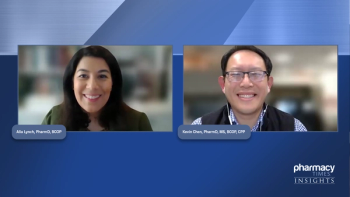
Addressing Disparities in Clinical Trial Settings
The panel highlights opportunities for inclusive populations within trials for HR+/HER2- breast cancer, as well as pharmacist-led initiatives in clinical trial settings.
Episodes in this series

Ryan Haumschild, PharmD, MS, MBA: In addition to these therapies, clinical trials play an important role. At our large academic centers, and even in the community, we’re seeing a large clinical trial uptick. That’s essential, because we have to bring data forward to have newer, innovative therapies and later lines of therapy for patients where there maybe isn’t a commercial option available. Dr Dent, maybe you can talk a little about the importance of clinical trials in the HR [hormone receptor]-positive, HER2-negative space. If you can, please hit on the diversity, equity, and inclusion piece around which patient populations are underrepresented and what we can do to help change that.
Susan Faye Dent, MD, FRCPC, FICQS: That’s a very good question. I’ve been involved in clinical trials throughout my whole career, and it’s so important. The only reason we’ve made advances in treatment is the clinical trials that have been done up to now. Unfortunately, when you look at the number of patients who participate, 5% or 10% at the most will enroll in these trials. That’s unfortunate because that means we aren’t getting the answers that we need as quickly as we’d like. When you look at the populations from racial and ethnic minority groups, it’s even worse. The participation rate is around 3%, and yet those are some vulnerable people who don’t do as well in general.
I can’t overstate the importance of participation in clinical trials. We have to do a better job of educating the public and educating racial and ethnic minority groups about the importance of trials. I still get people coming to my clinic saying, “I don’t want to be a guinea pig, I just want the best therapy.” They always say to me, “I want the best therapy.” You’re saying: “Of course we want to provide you with the best therapy. But we want to improve upon the best therapy. And how do we do it?”
We need to do a better job of educating patients so that they understand how important it is and that we aren’t going to compromise their health and outcomes for that clinical trial. Often these clinical trials are standard of care plus or minus the newer therapy. Or in earlier stages of trials, phase 1 and 2, patients have already been through all the standard therapies and we’re giving them hope that a brand-new therapy may give them some extra benefit.
The onus somewhat falls on us as health care providers to work with patients, communities, and patient advocates. I was recently at a clinical trial research meeting. We had a patient advocate say: “We need to work together. How can we help you and how can you help us? Let’s work together to bring this information out to the community so we can engage patients more, so they can feel they’re more a part of the process, rather than us pushing the process and pushing trials on them.” There’s lots of work to be done, but it’s very important because we want to make progress, and the faster the better. The faster we can get those answers, the better for patient care.
Heather N. Moore, PharmD, BCOP, CPP: I agree. The other thing we need to be mindful of is access for clinical trials for some of the patients you mentioned: racial and ethnic minority individuals or patients who may have health disparities. We need to think about what we can do for those patients. That’s where we need to have additional resources. I don’t think a patient should be excluded from a clinical trial because of previous issues in terms of compliance or [because of] a concern that they aren’t going to be able to make it to the clinic as frequently as they need to. That’s where we need the help of nurse navigators and social workers and [we need] to utilize the resources that we have within the community to make sure these patients still have access to clinical trials despite some of the barriers. That needs to be emphasized for a lot of those patients.
Ryan Haumschild, PharmD, MS, MBA: Diversity, equity, and inclusion in clinical trials is something that I’m very passionate about. Being in Atlanta, [I see] such an unmet need of diverse populations being enrolled. It’s such an opportunity for us as clinicians. ¼That’s an exciting piece ahead for us.
Dr Moore, when it comes to clinical trials, pharmacists play an important role. I’m familiar with pharmacists helping write some of the research orders, evaluating therapies, and determining what clinical trials might be best. Pharmacists review clinical trial data to aid providers in treatment selection. Some are co-PIs [principal investigators] on clinical trials and help enroll patients. Talk to me about your role and involvement in clinical trials with our HR-positive, HER2-negative patients.
Heather N. Moore, PharmD, BCOP, CPP: We can break this down into 2 sectors. One is being a resource to help with clinical trials in terms of helping to build clinical trial treatment plans and reviewing some of the protocols. We have our research pharmacy team specifically looking at that, but I’m always looking at those to make sure they make sense. Then there’s the clinical piece in terms of sequencing, monitoring, toxicity management, pre-med, so making sure that we’re reviewing it from that standpoint.
We also educate many of these patients. Because like Dr Dent mentioned, a lot of clinical trials build on our standard of care and maybe add an additional therapy. It’s educating those patients in terms of toxicities, things they may see at home, CINV [chemotherapy-induced nausea and vomiting], and some of those general things. We’re involved with the research team and thinking about new protocols or research ideas being presented, understanding the current literature, current understanding of therapies, targeted agents, and being able to provide a perspective in terms of what makes sense and whether this is something that we may need to modify a little for this to be the best trial. There’s that standpoint.
The other standpoint is that, in general, pharmacists have the ability to be involved in clinical trials not only from a co-investigator standpoint but also as a PI. For me, something that has been a big thing at Duke University is that I’m going to be the primary investigator for one of our EPIK studies. It’s EPIK-B4 [clinical trial (NCT04899349)], which is specifically looking at SGLT2 inhibitors in combination with metformin with alpelisib to help prevent essentially hyperglycemia and manage toxicity. It’s also utilizing our knowledge from a clinical standpoint. How can we implement that? How can we change that? My essential focus is toxicity management. That’s something that I’m passionate about and have looked at from a research standpoint.
I also think that we have the ability to do a lot of retrospective studies. We’ve done quite a bit looking at things that we can modify or change in clinic. We’re looking at some of our protocols, things that we’ve integrated, and then looking at that retrospectively to see what data we can gather from this, what benefit we can see, and how we can change this. We have the ability to be heavily involved in the clinical research space. Perhaps we’re underutilized at this point, but we’re getting there.
Susan Faye Dent, MD, FRCPC, FICQS: I agree. That’s a bit of a mind shift in academic medicine, but a good one. Traditionally, it’s always been the physicians who have been the PIs of studies, but we worked hard to make sure that Dr Moore could be the PI, at least for the Duke PI, for this study, and that speaks to what her strengths and interests are. There’s no reason we can’t have different health care providers leading these types of studies.
Transcript edited for clarity.
Newsletter
Stay informed on drug updates, treatment guidelines, and pharmacy practice trends—subscribe to Pharmacy Times for weekly clinical insights.




